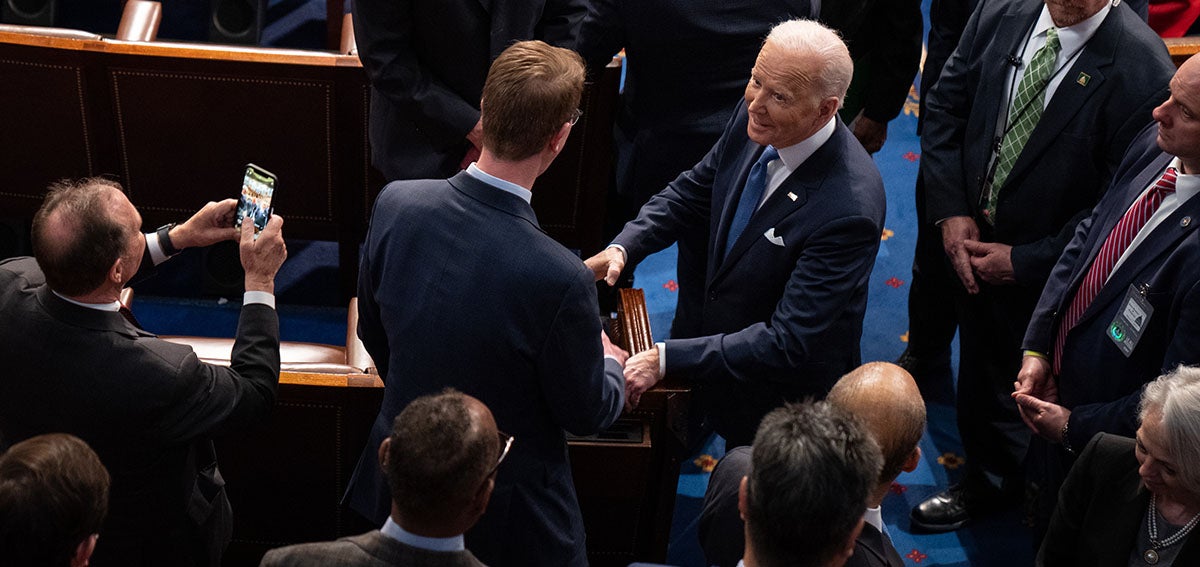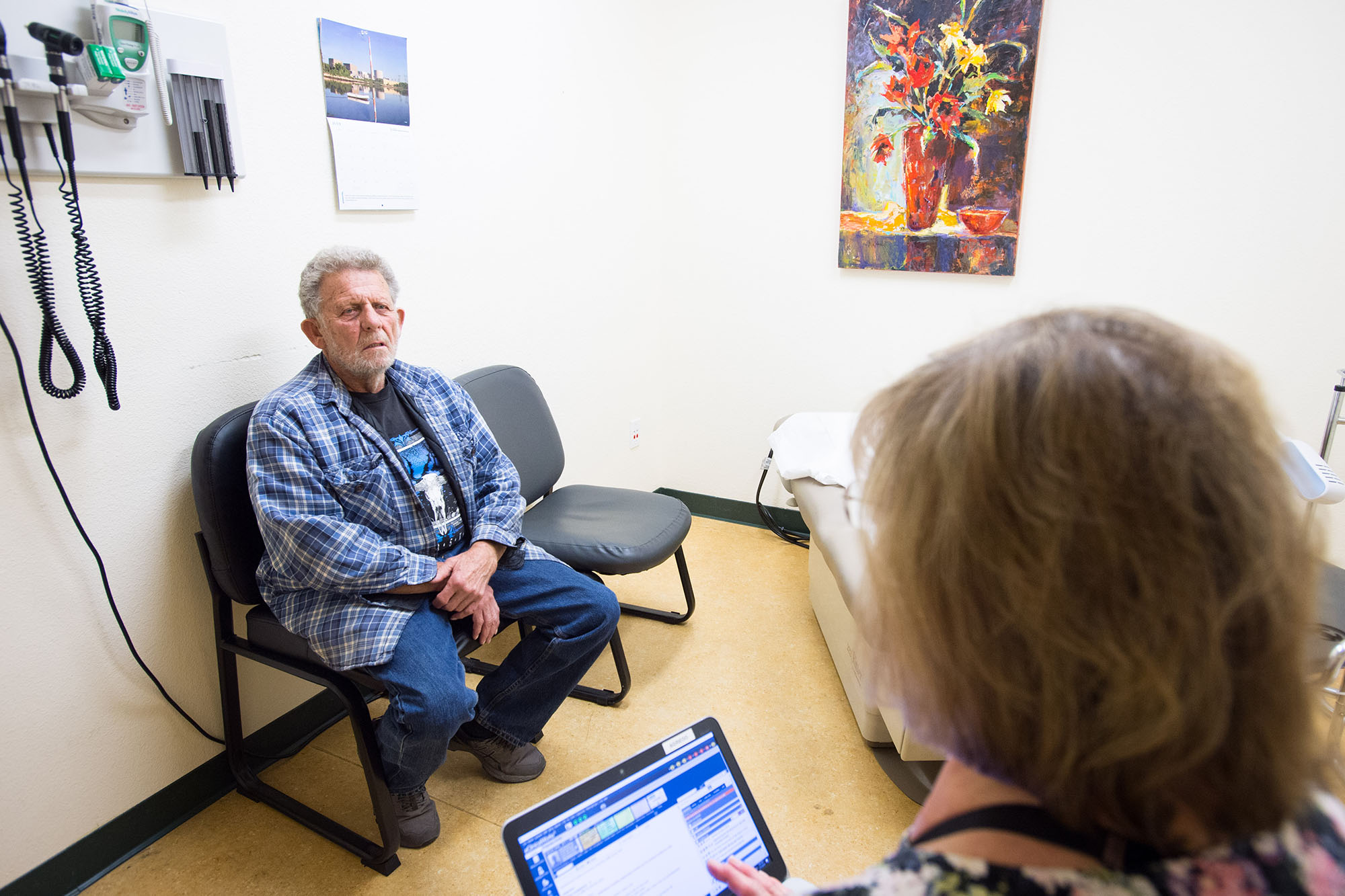
Update: On April 12, the US Department of Health and Human Services extended the COVID-19 public health emergency declaration. It will remain in effect until July 15, 2022.
When President Joe Biden delivered his first State of the Union (SOTU) address to the nation recently, it was intended to tout legislative accomplishments and present his policy priorities and solutions. With Biden’s approval rating currently around 42%, the SOTU provided the president an opportunity to build public confidence in the administration’s ability to govern and address ongoing challenges — primarily the COVID-19 pandemic, the Russian invasion of Ukraine, and rising inflation. Throughout the March 1 speech, the president highlighted an array of health-related priorities, including proposals in the Build Back Better Act (BBBA) (H.R. 5376) currently stalled in the narrowly divided Senate. He discussed the administration’s updated COVID-19 response, measures to lower the cost of prescription drug prices and Affordable Care Act (ACA) coverage, strategies to address the mental health crisis, plans to improve the quality of care at nursing homes, and his renewed Cancer Moonshot initiative. To fully carry out his plans, Biden will need support from Congress in the form of new authorities and additional funding. Some of the key items he touched on in the SOTU are already underway via administrative actions, while others require legislative efforts in Congress.
COVID-19 Response
Entering the Capitol maskless and shaking hands with lawmakers, Biden demonstrated the shifting focus of the administration’s pandemic response to “getting America back to our normal routines.” His speech focused on the four key goals of his new National COVID-19 Preparedness Plan: Protect against and treat COVID-19, prepare for new variants of the coronavirus, prevent economic and educational shutdowns, and continue to vaccinate the world.
The new emphasis on returning to normalcy signals that the COVID-19 public health emergency (PHE) may end soon. The PHE is currently scheduled to expire on April 16, 2022. However, early in the Biden administration, the Department of Health and Human Services (HHS) promised to provide states with 60 days’ notice (PDF) of a decision to terminate the PHE or let it expire. Since HHS did not give any indications by the 60-day mark on February 15, 2022, the administration is expected to extend the PHE at least until July 15, 2022.
In conjunction with the updated COVID-19 strategy, the Biden administration requested $22.5 billion from Congress for “immediate needs,” such as procuring therapeutics and vaccines and bolstering testing capacity. A lack of additional funding will have near- and long-term effects on the nation’s COVID-19 response, said an administration official. Immediate consequences include inadequate resources to purchase booster shots for all Americans if an additional shot is recommended, a shortage of monoclonal antibody treatments starting in May, and a shortage of preventive treatments for people with weakened immune systems by the end of the year. The Health Resources and Services Administration recently announced claims for COVID-19-related care for the uninsured will no longer be reimbursed “due to a lack of sufficient funds.” On March 22, the COVID-19 Uninsured Program stopped accepting claims for testing and treatment. (In California, the Department of Health Care Services announced on March 23 that it will still accept claims for those enrolled in the COVID-19 Uninsured Group Program.) On April 5, the COVID-19 Uninsured Program and Coverage Assistance Fund will stop accepting vaccination claims. Long-term consequences of no additional funding include the inability to develop vaccines against new variants and invest in research into new treatments.
Biden urged Congress to establish a $35 per month copay for insulin for people with diabetes who are enrolled in Medicare drug coverage or private health insurance.
Through the fiscal year 2022 appropriations omnibus, congressional Democratic leaders attempted to pass a smaller $15.6 billion COVID-19 supplemental bill, providing $9.85 billion to obtain therapeutics and vaccines, $750 million for vaccines against variants, and $5 billion for global health and humanitarian efforts. However, a sizeable group of Democrats pushed back against the use of $7 billion in unspent Coronavirus State and Local Fiscal Recovery Funds to help pay for the new COVID-19 package, forcing House leaders to remove the supplemental aid from the government funding bill signed into law on March 15, 2022. The Treasury Department is expected to distribute the second tranche of federal aid to local governments in May 2022. Now House leaders are trying to pass the COVID-19 supplemental bill on its own. Even if the aid package clears the House, it faces a challenging road in the Senate.
As part of the new preparedness plan, HHS launched the Test to Treat Initiative, a nationwide effort to minimize the time between a positive test result and receiving COVID-19 treatment. For Merck and Pfizer oral antivirals to be effective, they need to be taken within five days of symptom onset. At a “one-stop” Test to Treat location, a person will be able to receive a free test on-site or bring their test results from an at-home test, and — if they are positive and treatment is appropriate — receive a prescription and have it filled all in one visit. By March, HHS indicated that “hundreds” of “one-stop” locations will be available in pharmacy-based clinics, Federally Qualified Health Centers, long-term care facilities, and US Department of Veterans Affairs facilities. However, a lack of new funding will hinder its rollout. “Without additional funding, we do not have the ability to maintain our domestic testing capacity beyond June,” said an administration official.
Like the White House, Congress is also looking beyond the COVID-19 pandemic at ways to translate lessons learned into stronger pandemic preparedness. The Senate Health, Education, Labor and Pensions (HELP) Committee recently advanced the Prepare for and Respond to Existing Viruses, Emerging New Threats, and Pandemics Act (PREVENT Pandemics Act) (S. 3799) — bipartisan legislation focused on strengthening and modernizing federal public health and medical preparedness and response systems and programs. The Senate plans to vote on the bill in the coming months.
Health Care Costs
As part of his plan to “fight inflation” fueled by the pandemic, Biden proposes to lower the cost of prescription drugs and ACA coverage for consumers, which would require congressional action. While not specifically mentioning BBBA, the president highlighted some of its major health provisions. Whether these proposals could be advanced through a narrower budget reconciliation package, requiring only a simple majority in the Senate, remains to be seen.
Biden urged Congress to establish a $35 per month copay for insulin for people with diabetes who are enrolled in Medicare drug coverage or private health insurance. Approximately 70% of people with diabetes with commercial insurance spent more than $35 per month on insulin in 2019, according to the Health Care Cost Institute. The president also urged Congress to authorize Medicare to negotiate drug prices, which would help reduce premiums and out-of-pocket costs for Medicare enrollees. Under the BBBA, HHS would be allowed to negotiate prices with drug manufacturers for a small number of high-cost drugs covered under Medicare Part B and Medicare drug plans. This would include single-source brand-name drugs or biologics without generic equivalents and all insulin products.
HHS plans to award over $225 million in training programs to increase the number of community health workers providing help to underserved communities, including behavioral health support.
In addition, Biden called on Congress to permanently increase the availability and amount of advance premium tax credits (i.e., subsidies) for ACA coverage, as was done temporarily under the American Rescue Plan Act (ARP). Without congressional action, these changes will expire at the end of 2022. The BBBA would continue them in three ways:
- Extend subsidies through 2025 to people with an income above 400% of the federal poverty level ($106,000 for a family of four) to help ensure no one pays more than 8.5% of their income toward premiums in the individual market.
- Increase the subsidy amount through 2025 for people with incomes between 100% and 400% of the federal poverty level.
- Allow people who receive unemployment benefits in 2022 to qualify for maximum subsidies, an enhancement that expired at the end of 2021.
Due in part to the ARP premium enhancements, nearly 1.8 million Californians enrolled in an ACA plan during the 2022 open enrollment period, a 9% increase over 2021.
Mental Health and Substance Use
In response to increased rates of depression, anxiety, and substance use exacerbated by the COVID-19 pandemic and resulting economic hardships, President Biden outlined key components of his strategy to address our national mental health crisis. The plan includes top priorities in the president’s soon-to-be-released fiscal year 2023 budget request, including greater investments to expand the mental health workforce and increase access to services, as well as forthcoming administrative actions. Among these priorities:
- This July, HHS will launch the “Dial 988” National Suicide Prevention Lifeline. Through ARP, the Substance Abuse and Mental Health Services Administration provided $282 million to support the transition to the three-digit dialing code, including $177 million to strengthen and expand existing Lifeline network operations and $105 million to build staffing across states’ local crisis call centers.
- In fall 2022, HHS plans to award over $225 million in training programs to increase the number of community health workers and other health support workers providing services in underserved communities, including behavioral health support.
- Through the bipartisan Dr. Lorna Breen Health Care Provider Protection Act (P.L. 117-105) recently signed into law, HHS will award $135 million over three years to train health care providers on suicide prevention and behavioral health while launching an awareness campaign to address stigmatization and to promote help-seeking and self-care among this workforce.
On the congressional front, key Senate committees are working on bipartisan legislation that mostly aligns with priority areas identified in the president’s strategy. They aim to introduce their bills in the summer, though timing of floor votes is uncertain.
CMS plans to help states link Medicaid payments with clinical staff wages and benefits and support a nationwide campaign to recruit and retain long-term care workers by opening pathways to careers like nursing.
The Senate Finance Committee aims to introduce legislation this summer that will focus on five areas:
- Strengthening the workforce
- Increasing integration, coordination, and access to care
- Ensuring parity between behavioral and physical health care
- Furthering the use of telehealth
- Improving access to behavioral health care for children and young people
The Senate HELP Committee is also crafting its own bill that tackles many of these issues. At a hearing in February, HELP Committee members coalesced around these overarching themes to guide their policy development: (1) Advance health equity and prioritize federal resources for communities that are underserved by mental health and behavioral health systems, (2) support evidence-based and community-based solutions, (3) tackle the continuum of mental and behavioral health challenges with increased focus on social determinants of health, and (4) acknowledge and address stigma.
Nursing Home Standards
To address the disproportionate impact of COVID-19 on nursing home residents, the president announced the administration’s plans to set “higher standards for nursing homes.” This includes establishing minimum adequacy standards and updating infection prevention and control requirements. The US Centers for Medicare & Medicaid Services (CMS) intends to increase oversight over nursing homes through various compliance strategies, some of which will require Congress to grant new authorities and provide additional funding. CMS plans to help states link Medicaid payments with clinical staff wages and benefits, partner with stakeholders on a nationwide campaign to recruit and retain long-term care workers by opening pathways to careers like nursing, and improve education and training reimbursement for nurse aides.
The “Cancer Moonshot” Initiative
Biden discussed his plan to “supercharge the Cancer Moonshot,” the initiative he launched during the Obama administration to accelerate research on the many different types of cancer. The renewed effort aims to reduce the death rate from cancer by at least 50% over the next 25 years and improve the experience of people and their families living with and surviving cancer.
A major component of the president’s initiative is establishing the Advanced Research Projects Agency for Health (ARPA-H), a new agency that would be tasked with “catalyzing transformative health breakthroughs that cannot readily be accomplished through traditional research or commercial activity.” ARPA-H would support projects to prevent, treat, and cure a range of diseases, including but not limited to cancer, Alzheimer’s disease, and diabetes.
The fiscal year 2022 appropriations omnibus provides $1 billion to establish ARPA-H, much less than the $6.5 billion requested in President Biden’s budget. Though Congress has provided start-up funding for ARPA-H, lawmakers still need to pass legislation authorizing the new agency and setting forth its details, such as its governance, leadership, and structure. The PREVENT Pandemics Act advanced by the Senate HELP Committee includes language authorizing the creation of ARPA-H.
Looking Ahead
In his SOTU, President Biden laid out a policy agenda that reflects his priorities with respect to lowering health care costs, lessons learned from the COVID-19 pandemic, and his personal mission to harness science to vanquish cancer someday. It’s not yet clear whether Congress will be able to work together on a bipartisan basis to address these and other priorities.
Authors & Contributors

Alyssa Llamas
Alyssa Llamas is a policy director at the Wynne Health Group. She has a diverse background in health policy and public health, including experience in government, research, and nonprofit settings. Llamas previously worked at the US Centers for Disease Control and Prevention.

Dawn Joyce
Dawn Joyce is a vice president with the Wynne Health Group and a health policy expert. She has hands-on experience at the federal, state, and local levels, and previously served as a staff member for California senator Dianne Feinstein.
Joyce is a graduate of Wellesley College and UC Berkeley’s School of Public Health.

Sarahbeth Maney
Sarahbeth Maney, also known as SB, is a photojournalist originally from the Bay Area. Her personal work focuses on education, disability, and issues that disproportionately affect communities of color. SB received a grant from the Pulitzer Center to continue documenting a story about pregnancy and housing inequality during the coronavirus pandemic. She currently covers politics at the New York Times Washington bureau as a 2021–22 photography fellow.




